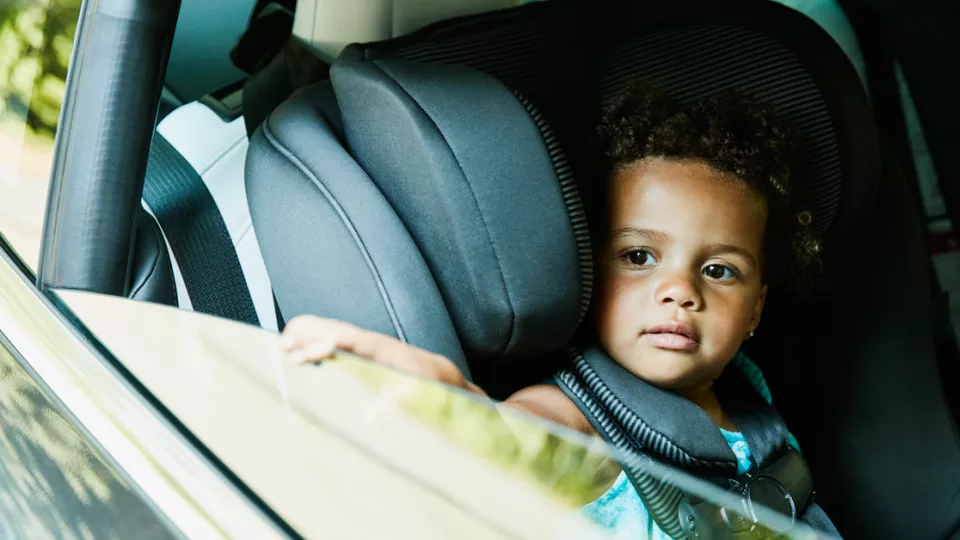
Kids in Cars: Look Before You Lock
It sounds mind-boggling. Who would leave their baby or young child locked in a car, alone—especially on a hot day?
“The answer is Any Parent, USA,” says Helen Arbogast, DrPH, MPH, CPSTI, Manager of Injury Prevention at Children’s Hospital Los Angeles. “It’s across income levels, education, ethnicity and age. No parent thinks this can happen to them, but it can happen to anyone.”
How do children get left in cars?
According to the advocacy group KidsandCars.org, an average of 39 children die each year of vehicular heatstroke in the U.S. In 2019, 53 children died.
In most cases, parents or caregivers simply forgot the child was in the back seat. If the child is sleeping or in a rear-facing car seat, this happens more easily than you might think—especially if a parent is stressed or sleep-deprived, or if there was a change from the normal routine.
Small children can also get trapped in cars at home. A young child can wander into the car, searching for a left-behind toy or playing hide-and-seek. But once inside with the doors shut, the child doesn’t know how to get out.
Kids—and cars—heat up fast
“Many people think it has to be 105 degrees outside for a child to die in a car,” Arbogast says. “It doesn’t have to be that extreme. It can be 80 degrees outside, but could be 105 to 120 degrees inside the car.”
Babies and young children are most at risk due to the following reasons:
- A child’s body heats up three to five times faster than an adult’s.
- In just 10 minutes, the inside of a car can heat up 20 degrees.
- In a hot car, a child’s organs can start shutting down when his or her temperature reaches 104 F. At 107 F, the child can die.
6 ways to stay safe
To keep your child safe, follow these simple tips from Dr. Arbogast and KidsandCars.org:
1. Look before you lock!
When you leave your car, ALWAYS open the back door and check the back seat before you lock your doors and walk away. Do this every single time—even if you’re 100% certain your child is not with you. Make it a habit to check.
Tell anyone who will be driving your child to also look before they lock. “It’s really important,” Arbogast says. “Just take a few seconds and do that double-check.”
2. Put your purse or phone in the back seat.
This habit forces you to check the back seat before you walk away. Simply place an item back there that you will have to take with you, such as a purse, briefcase, phone or employee badge.
3. Talk to your child care provider.
Tell the provider to call you right away if your child is not dropped off on time.
A sleep-deprived parent who doesn’t normally drop off a baby at day care might drive to work on auto-pilot, completely forgetting the baby is with him or her on that day. This has happened to real-life parents—with devastating results. A prompt call from the child care provider can be lifesaving.
4. Lock your car at home.
Always keep your car locked, whether it’s in the driveway, on the street or in the garage. Ask visitors, relatives, neighbors and child care providers to do the same.
In addition, keep car keys and remote openers out of kids’ reach.
“This is a big concern right now because more parents are working from home during COVID-19,” Arbogast explains. “You want to make sure a child can’t get into a car while you’re not looking.”
5. Be extra alert if you change your routine.
According to KidsandCars.org, many of these tragedies occur when a schedule or routine changes. Busy times and periods of crisis also raise the risk of an accident. Be extra alert during these times.
6. Don’t assume you’ll be right back.
It can be tempting to run inside a store “for just a few minutes” to pick something up, while leaving your young child alone in the car. Don’t do this—ever. (It is illegal in California to leave a child under 6 alone in the car.)
“Kids can overheat very quickly,” Arbogast says. “And you can plan to go in for one or two things and then get delayed. Never leave a child or baby alone in the car, even for a minute, no matter what the temperature is that day.”


